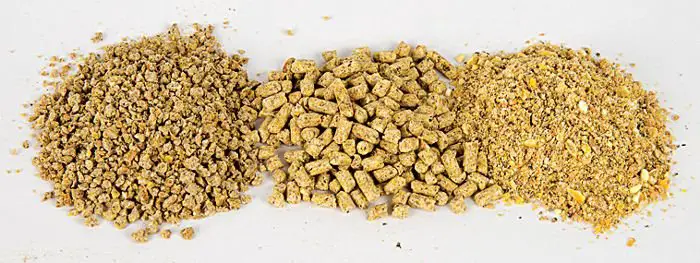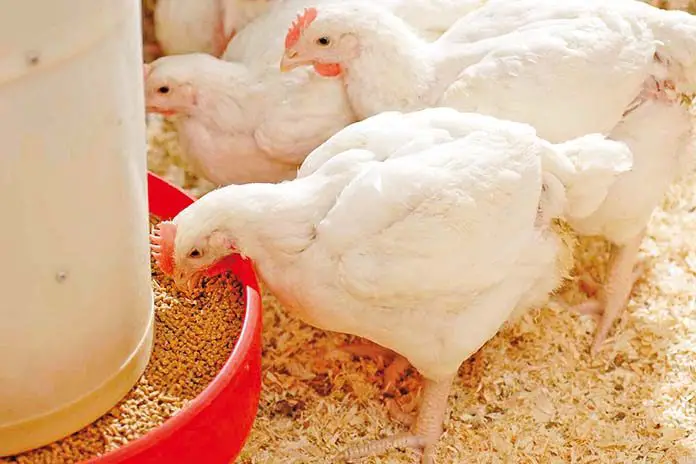Layers are predominantly grown for their egg-laying ability. The feeding of these chickens especially under intensive conditions determines the type of feed and ingredients that go into the layers mash feed as feed will only be as good as the ingredients used. For laying chickens the most important nutrients will be energy, protein, and calcium as the hen uses these to sustain its own growth and egg production. This article will outline layers mash ingredients.
Contents
Key Nutrients and Their Sources
Energy mainly comes from the starch in grains that the birds eat but can also be derived from oils within these grains. Protein which is an essential nutrient for the growth of the hen and the production of eggs comes from seeds and insects that the hens consume. The eggs come covered with a hard shell cover that protects the contents of the eggs and sometimes the developing embryo. This shell is made up of calcium carbonate which makes calcium a very important nutrient in layer feeding. Most of the calcium comes from calcium-rich limestone but can also come from the exoskeletons of insects or marine shellfish.
To better understand the contribution of the different layers mash ingredients, we are going to break them down into 4 categories with are most important for the hen’s productivity energy, protein, calcium, and fiber.
Energy Sources of Layers Mash Feed
Maize
This is the most important grain in chicken feed and is usually available either as white or yellow. Both varieties regardless of color have an almost similar nutrition profile averaging 8% protein and 14.2Mj/kg energy. Maize is also important as a layers mash ingredient because it does not have any problems or restrictions when included in the feed as you will see with other layers mash feed ingredients. Aflatoxins, which are toxins produced by molds, can be a challenge for maize, especially in humid climates but proper drying of the maize both pre and post-harvest can reduce the risk. Maize can make up on average 50% of the layers mash chicken feed.
Sorghum
Grain sorghum is a drought-resistant crop and is good in areas with low rainfall patterns, because it has a relatively similar profile to maize it is used as a substitute for maize. However, its crude protein levels tend to vary a lot depending on variety and growth conditions, unlike maize. Some red varieties “bird proof”, contain a substance that stops wild birds from consuming the grain in the fields, this also, unfortunately, affects chickens and can lead to low feed consumption. High tannin sorghum hence should not be included at levels higher than 15% in the feed. Grains that grow in similar conditions like millet can also be used as layers mash ingredients, they act as maize substitutes, replacing up to 60% of maize in layer feeds without any disruption in productivity.
Wheat and Barley
These grains are used internationally to feed layer chickens although in most cases the grain feed will have been deemed substandard for baking and brewing. These grains are also mostly included as whole grains in the feed to reduce the effect of the viscous starch present in these grains.
Fat and Oils
Fat and oils are some of the ingredients used in layers mash feed. These energy sources are mostly used to partially substitute maize; however, they cannot be included in levels higher than 3% as they can easily go bad spoiling the feed.
Molasses
This is a syrup that comes from the purification of sugar, hence has a relatively high energy content but unfortunately no protein. The other uses for molasses in the layers mash feed are to improve feed appearance and binding pellets if these are being fed to layer chickens.
Protein Sources of Layers Mash
Most protein sources for chicken feeding are products of vegetable oil extraction from oil seeds like soya beans, sunflower, cotton, and sesame seed, products from the processing of animals in slaughterhouses can also be used. Synthetic amino acids, the building blocks of protein can be added to feed to supply any that could be lacking from natural sources.
Soya Bean Meal
Soya bean meal comes from the extraction of edible oils from soya bean seeds, it is one of the biggest ingredient which provides protein in layer feeds at an average crude protein level of 45%. Unfortunately, the raw bean contains a substance called trypsin inhibitor that affects the layers chicken’s ability to digest protein properly. This substance can however be destroyed by heat, so when processing the soya beans heat is applied to destroy this substance. Feeding of under or over-processed soya bean meal has a huge impact on the performance of layers hence the ingredient needs to be tested before use in the layers mash feed.
Sunflower Meal
Sunflower is a relatively good protein source for layers mash feed, with very variable protein levels from 22% to 44% depending on processing. Another challenge with sunflower meals is the high fiber content if the seeds are crushed whole with the husk included during the oil extraction process.
Animal Proteins
These are cooked by-products from meat processing, examples include fish, blood, carcass, or a mixture of blood and carcass meal. Their inclusion in layers mash feeds is on average 5-10% due to the fact that they are quite expensive and some like fish meals can give eggs a fishy smell.
Calcium sources of Layers Mash
Calcium is another important nutrient in egg production as it forms the eggshell. The main source of calcium in layers mash feed is the calcitic limestone ingredient. Other sources of calcium in layers mash feed include oyster shells, snail shells, and dried egg shells, both sources can be fed finely or coarsely ground with a third being coarsely ground.
Fiber Sources of Layers Mash Feed
Chickens have an inherent need for fiber in their feeds to maintain good gut health, a lack of fiber in some cases has been reported to cause cannibalism within flocks. Thus layers mash feed ingredients should include fiber sources. Fiber mainly comes from products of grain milling like maize, wheat, and rice bran. These by-products also help as fillers for the feed bringing down the overall cost of the layers mash feed
Vitamins and Mineral Premixes
To balance the feed for essential vitamins and amino acids, commercially designed and formulated vitamin-mineral premixes are added to the layers mash feed in small amounts. However, the importance of these premixes cannot be overstated as deficiencies in vitamins or amino acids can have severe consequences on the productivity and health of the chickens.




